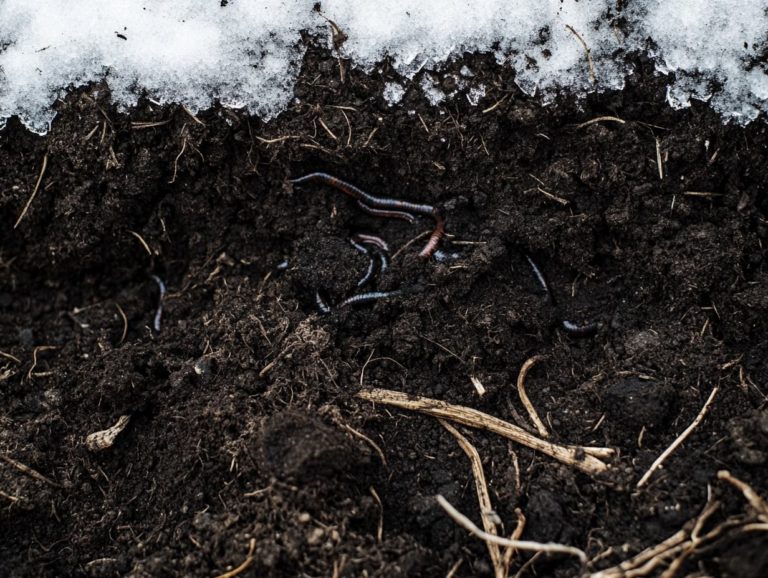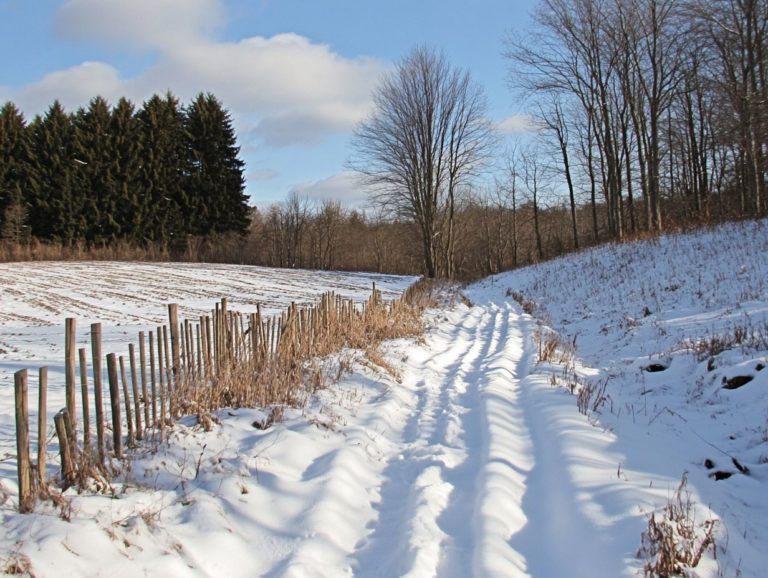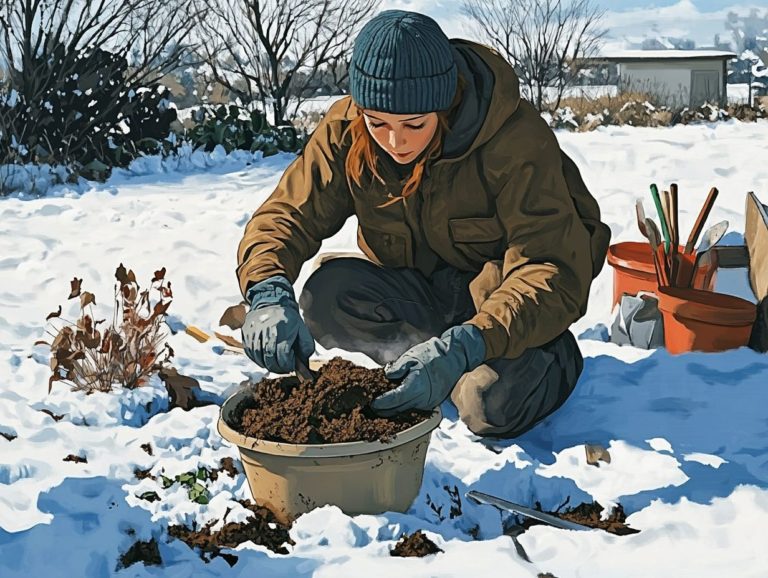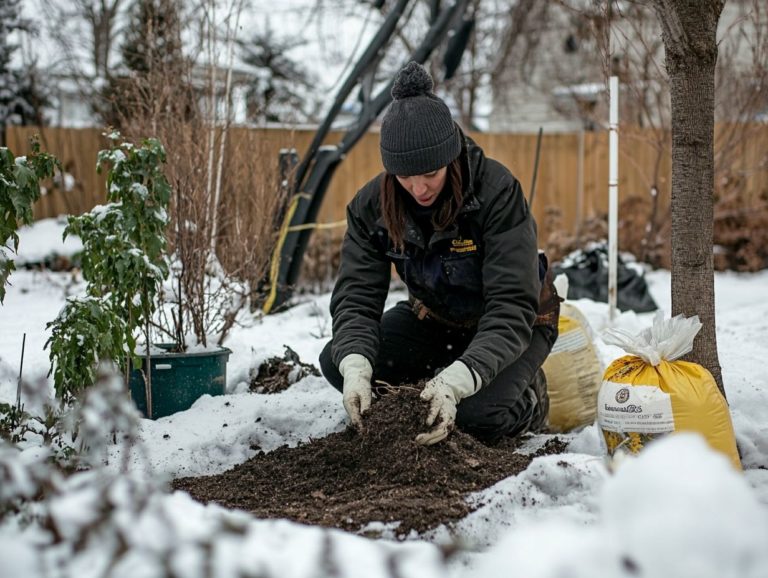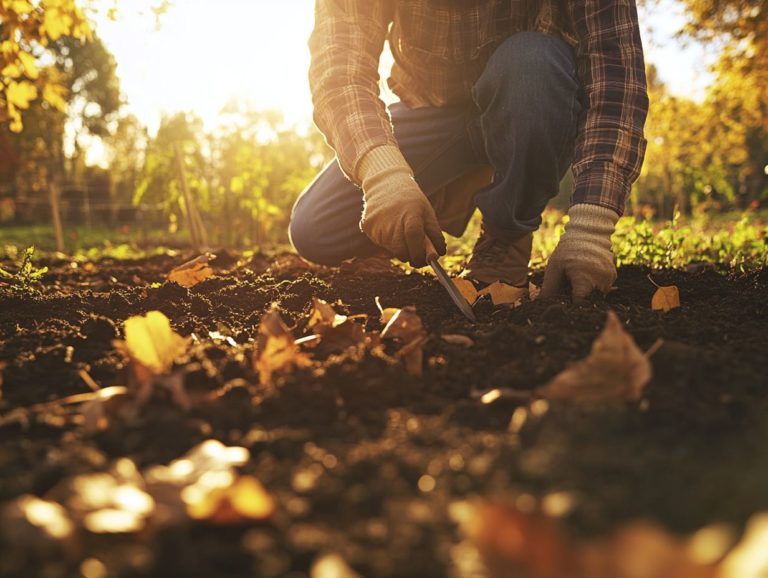Cold-Climate Gardening: Soil Preparation Tips
Gardening in cold climates presents unique challenges. However, it also offers opportunities that differ from traditional gardening.
Choosing the right plants is critical. Preparing your soil is equally important for your garden’s success.
This guide is your ticket to mastering cold-hardy plants! Get ready to transform your garden with insights on selecting the best options, amending your soil, and protecting against frost.
With practical tips on watering, fertilizing, and pest management, you’ll be well-equipped to create a thriving garden, even in the chilliest conditions.
Dive in and cultivate your own cold-climate oasis!
Contents
- Key Takeaways:
- Understanding Cold-Climate Gardening
- Choosing the Right Plants for Your Garden
- Preparing Your Soil for Cold-Climate Gardening
- Protecting Your Plants from Frost and Cold
- Tips for Successful Cold-Climate Gardening
- Frequently Asked Questions
- What is cold-climate gardening?
- Why is soil preparation important in cold-climate gardening?
- What are some tips for preparing soil in cold-climate gardening?
- How far in advance should I start preparing my soil for cold-climate gardening?
- Preparing Your Soil for Cold-Climate Gardening
- Is it possible to improve soil quality in cold-climate gardening?
- Can I use the same soil preparation techniques for all plant types in cold-climate gardening?
- No, different plants have different soil needs. It’s crucial to research the specific soil requirements for the plants you want to grow in your cold-climate garden. For instance, heirloom seeds may require specific conditions to thrive. Always consider your garden zone when selecting plants.
Key Takeaways:

- Choose cold-climate plants that can withstand freezing temperatures and short growing seasons.
- Test and improve your soil to provide essential nutrients and drainage.
- Protect your plants from frost with methods like mulching or covering with blankets.
Understanding Cold-Climate Gardening
Understanding cold-climate gardening is essential for growing outdoor crops well, especially in regions like Wyoming and Alaska, where frost dates define the growing season. To improve your soil quality, learn how to amend clay soil for cold-climate gardening.
You must adapt your strategies to navigate these shorter seasons. Local gardening resources and expert guidance will help you choose the right crops and methods.
Embracing techniques like raised beds and season extenders can significantly improve your soil and moisture retention. This enables you to cultivate a diverse array of plants despite challenging conditions.
What Makes Cold-Climate Gardening Different?
Cold-climate gardening presents a world of difference compared to traditional gardening due to unique challenges like frost, limited growing seasons, and careful selection of heirloom seeds. Understanding the role of soil in sustainable cold-climate gardening can greatly enhance your gardening success.
These challenges require a thoughtful approach to cultivation. Pay close attention to soil temperature and moisture levels for successful harvests. Understanding your local climate is key, as it influences your plant choices and frost protection methods.
You ll need to master techniques like using row covers or mulching to shield your plants from surprise cold snaps.
Opting for hardy varieties that endure lower temperatures and shorter growing periods will significantly impact your crop yield. This ensures that every plant has the best chance to thrive.
Choosing the Right Plants for Your Garden
Selecting the ideal plants is crucial, particularly in a cold climate where your choices can greatly influence your gardening success.
By carefully choosing the hardiest plants suited to your specific conditions, you lay the foundation for a flourishing garden that can withstand environmental challenges.
Factors to Consider for Cold-Climate Plants
When selecting cold-climate plants, consider factors like plant hardiness, frost dates, and the soil’s moisture retention ability.
Frost dates indicate the last frost in spring and the first frost in fall, shaping your planting schedule. Knowing these dates helps optimize your crop yields and ensures your plants thrive.
The structure of your soil is crucial for moisture retention. Well-aerated soil improves drainage, preventing root drowning while keeping necessary moisture. This balance directly impacts the growth potential of various plant species.
Preparing Your Soil for Cold-Climate Gardening
Preparing your soil is essential for optimal soil health and structure. This involves practices such as conducting soil tests, adding organic matter, and fixing drainage issues.
By taking these steps, you create a thriving environment for your plants, setting the stage for a bountiful garden even in challenging conditions.
Testing and Amending Your Soil
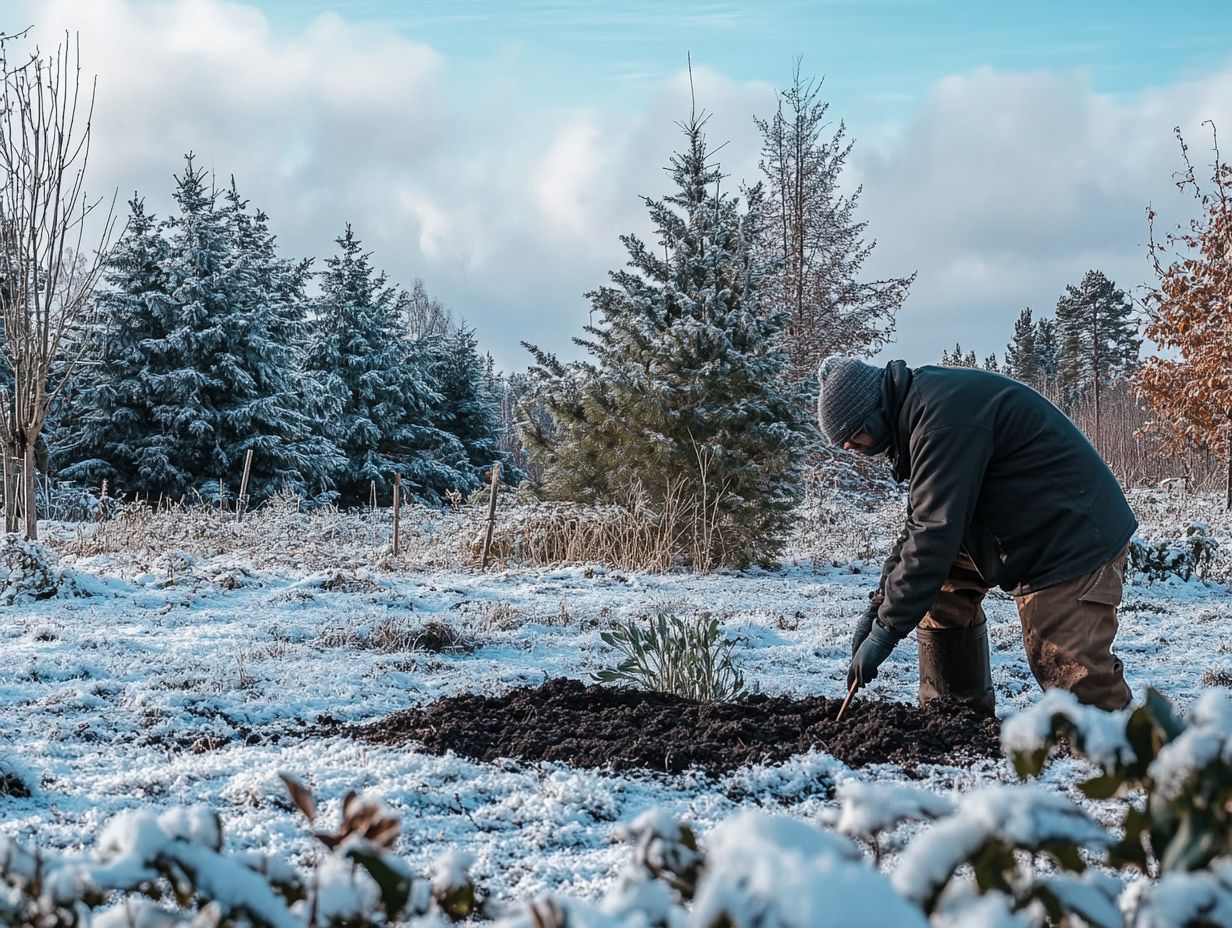
Soil testing is an essential step in preparing your garden for cold-climate gardening. It reveals the nutrient availability and highlights the need for organic amendments, which are natural materials that improve soil health. For more insights, consider these essential cold-climate gardening techniques.
Start by collecting soil samples from different spots in your garden. This gives you a well-rounded understanding of your soil’s composition.
Once the samples are analyzed, interpreting the results will help you identify deficiencies in macronutrients (key nutrients plants need in large amounts) like nitrogen, phosphorus, and potassium, along with micronutrients (the smaller but still essential nutrients).
With this knowledge, you can select the right organic amendments like compost, aged manure, or green manure. Maintaining robust soil health fosters vibrant plant life and builds resilience against pests and diseases.
Protecting Your Plants from Frost and Cold
Safeguarding your plants from frost and cold is crucial in cold-climate gardening. Use effective methods like protective covers, mini hoop houses, and row covers to shield your tender crops.
Methods for Frost Protection
Employ several strategies for frost protection, such as cloches that create a warm microclimate for vulnerable plants throughout the growing season.
Consider using frost blankets or row covers. These barriers protect your plants from cold air while allowing sunlight and moisture to nourish them.
Experts recommend covering sensitive crops in the evening as temperatures drop and removing these covers in the morning to prevent overheating.
Mulching is another invaluable technique. It insulates the soil, reducing temperature fluctuations and protecting the roots from harsh cold.
By combining these strategies and following expert gardening advice, you can effectively protect your plants and enhance your garden’s resilience against unexpected frosts.
Tips for Successful Cold-Climate Gardening
Successful cold-climate gardening relies on a select few essential strategies. These include effective watering methods, proactive pest control, and understanding how to amend soil for cold climates, along with specialized winter gardening techniques.
Implementing these practices allows you to extend your growing season and boost your yields.
Watering and Fertilizing Strategies
Effective watering and fertilizing strategies are vital for maintaining soil fertility in your cold-climate garden. Here, organic amendments and compost play a crucial role in supporting plant health.
In these regions, timing is key. As temperatures drop, plant growth slows down, so adjust your watering frequency and techniques accordingly.
Apply organic amendments during the fall or spring for the best results. This allows them to break down, enhancing soil structure for better moisture retention and nutrient availability.
During winter, avoid watering when the ground is frozen to prevent harm. Instead, use mulch to insulate the soil, reduce evaporation, and keep nutrients accessible for your plants.
Dealing with Pests and Diseases
Dealing with pests and diseases in cold-climate gardening demands a proactive strategy, emphasizing effective pest control methods and using organic gardening methods to sustain plant health.
As a gardening enthusiast in these regions, you should prioritize early detection techniques, as they can greatly reduce the likelihood of infestations. Simple practices, like regularly inspecting your plants and soil, will help you spot the first signs of trouble before it escalates.
Incorporating companion planting strategies and using organic pesticides not only strengthens your crops but also minimizes the impact on beneficial insects. Local gardening resources, such as extension services and community workshops, provide valuable insights for your pest management efforts, tailored specifically to the unique challenges posed by your climate.
Frequently Asked Questions
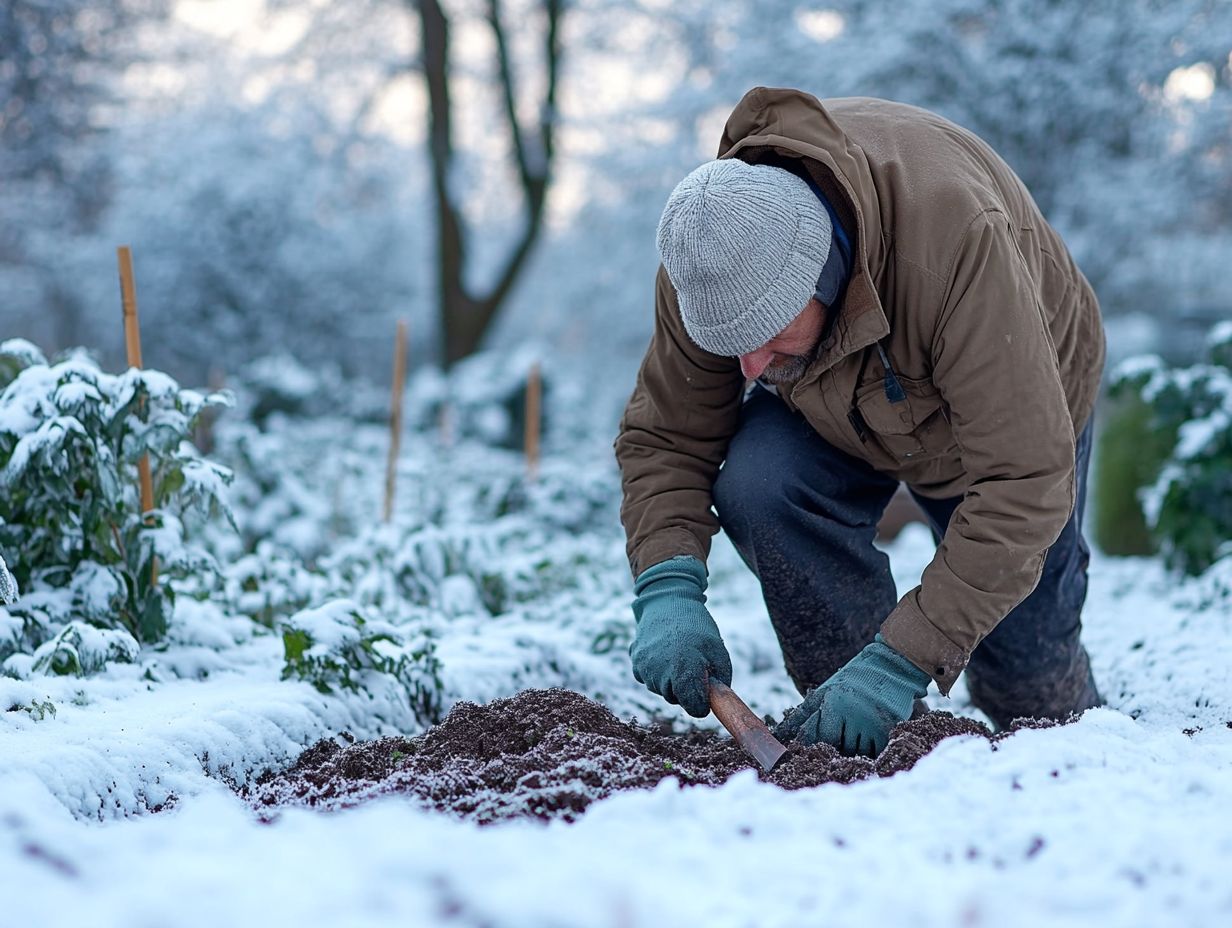
What is cold-climate gardening?
Cold-climate gardening refers to the practice of gardening in areas with cold and often harsh winter conditions, such as frost, snow, and low temperatures. This includes techniques suitable for various regions, like Wyoming and Alaska.
Why is soil preparation important in cold-climate gardening?
Soil preparation is essential! Harsh weather can challenge your plants, but with the right soil, they can thrive. Preparing soil for cold-weather perennials properly can help provide a healthy and nutrient-rich environment for plants to grow and withstand the harsh conditions. Organic amendments like compost can significantly enhance soil fertility.
What are some tips for preparing soil in cold-climate gardening?
To prepare soil in cold climates, add organic matter like compost or manure. For more detailed guidance, check out soil preparation for container gardening in cold climates. Testing soil pH and using raised beds or containers can improve drainage and warmth.
Local gardening experts recommend utilizing cover crops to enhance soil nutrient availability.
How far in advance should I start preparing my soil for cold-climate gardening?
Preparing Your Soil for Cold-Climate Gardening
Start preparing your soil now! Give it 2-3 weeks before planting to ensure the best results. This timeframe allows any amendments to properly integrate into the soil and gives it a chance to warm up to a suitable temperature.
Knowing your frost dates can help you effectively plan your planting guide.
Is it possible to improve soil quality in cold-climate gardening?
Yes! You can improve soil quality in cold-climate gardening. Adding organic matter, utilizing cover crops (plants grown to improve soil health), and following preparing your soil for spring in cold climates by changing the type of plants you grow each season are effective methods.
Soil testing can reveal what amendments you need for optimal soil health.
Can I use the same soil preparation techniques for all plant types in cold-climate gardening?
No, different plants have different soil needs. It’s crucial to research the specific soil requirements for the plants you want to grow in your cold-climate garden.
For instance, heirloom seeds may require specific conditions to thrive. Always consider your garden zone when selecting plants.
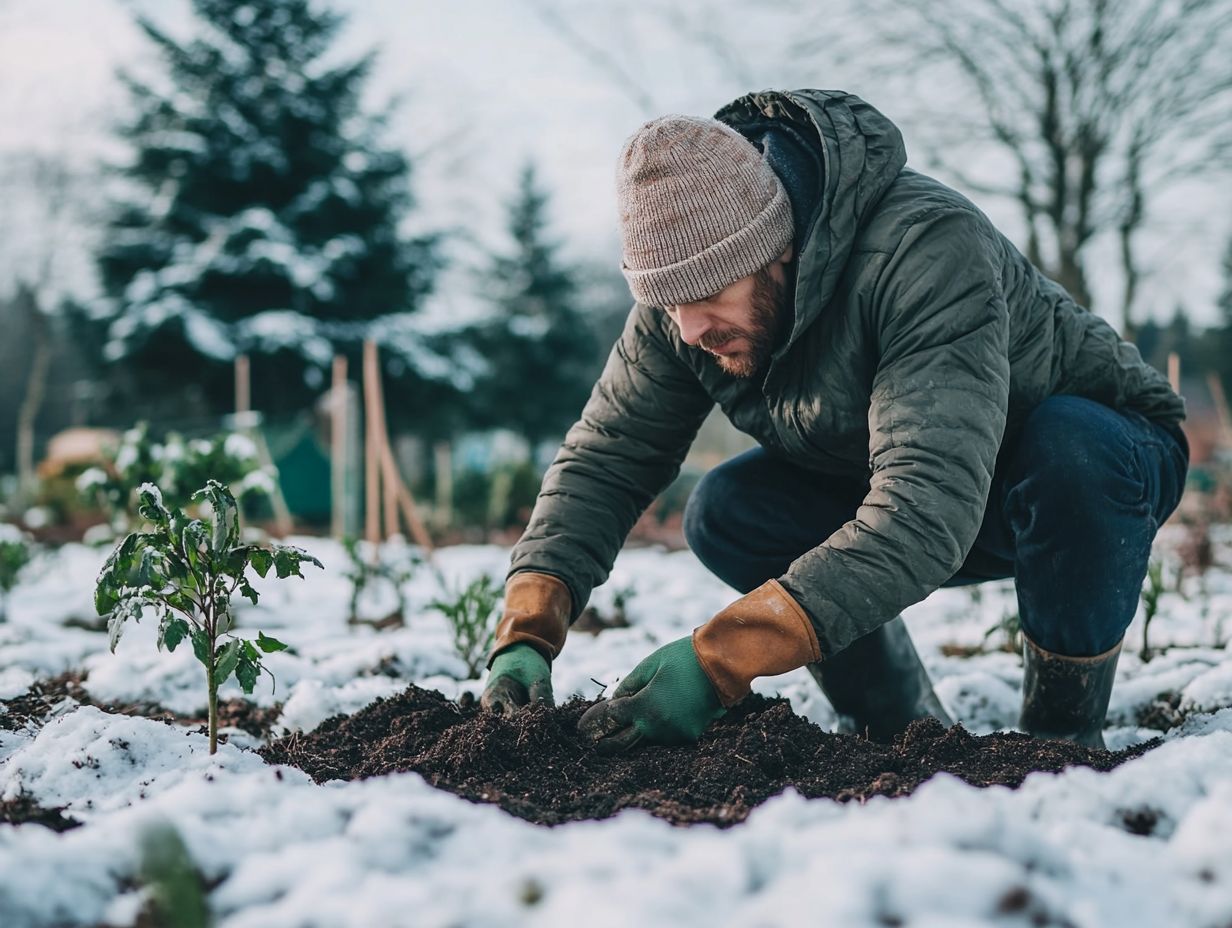
Get your garden ready now! Start preparing your soil at least 2-3 weeks before planting. This gives time for any changes to mix into the soil and warm it up for planting.
Knowing your frost dates will help you plan your planting effectively.
Yes, you can improve soil quality in cold-climate gardening. Adding organic matter and using cover crops are effective methods, but understanding the importance of soil testing is also crucial for achieving the best results.
Practicing crop rotation can also enhance soil quality over time. Soil testing helps identify specific amendment needs.
No, you can’t use the same soil preparation techniques for all plants. Each type has its unique soil requirements.
For example, some plants thrive in acidic soil, while others prefer alkaline conditions. Research is key to success!


